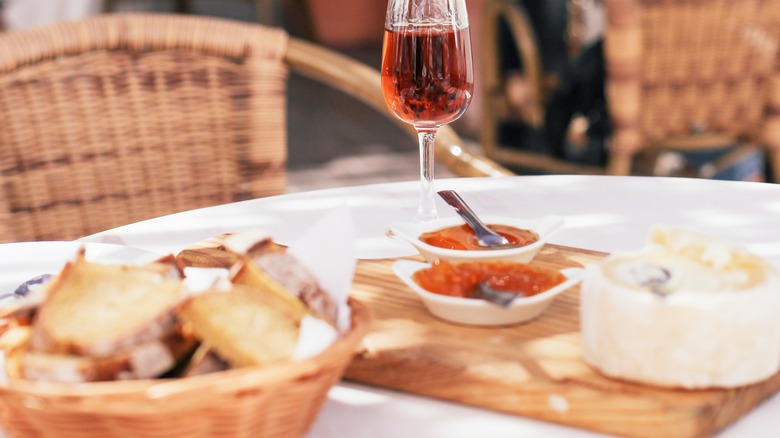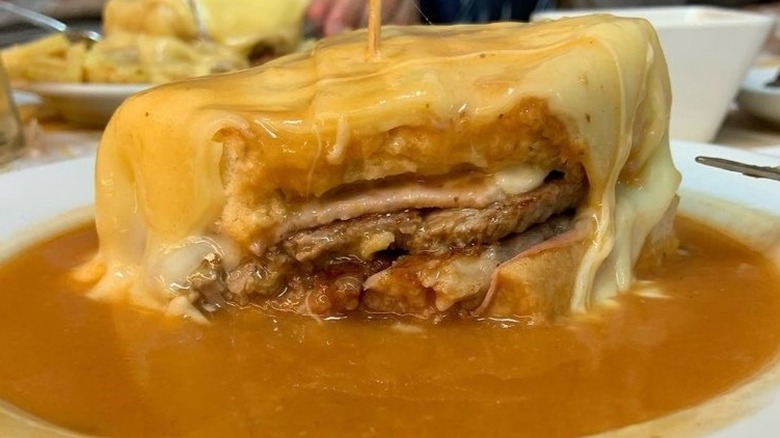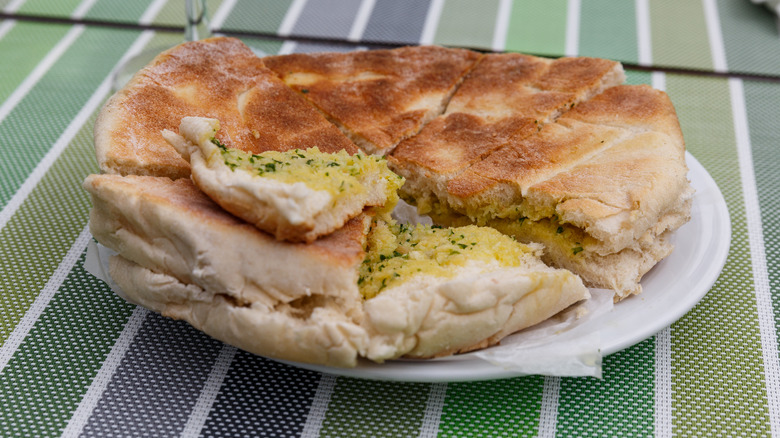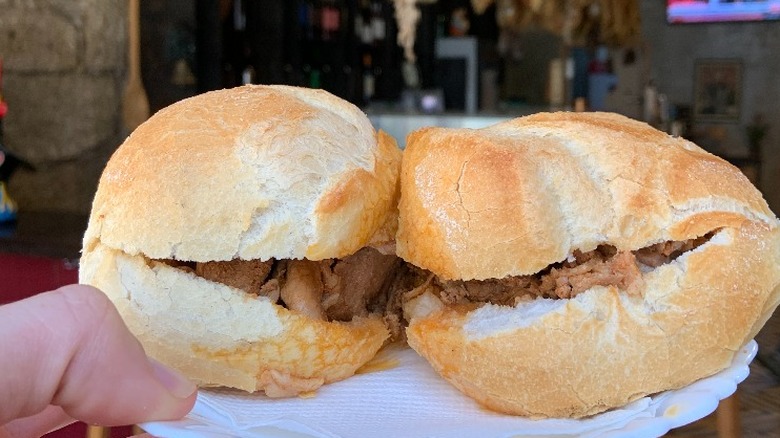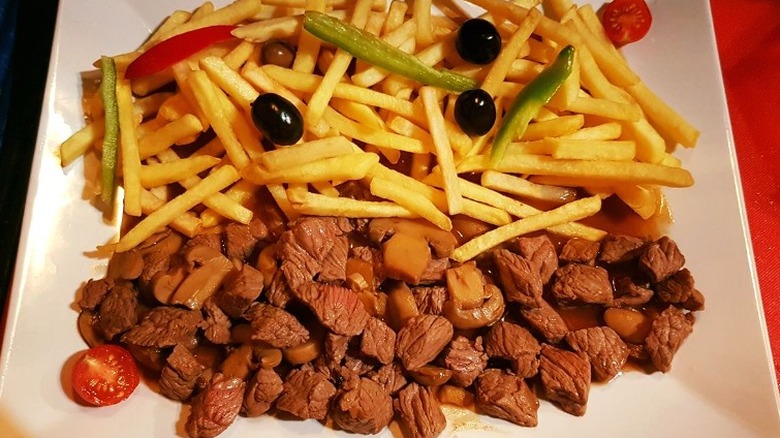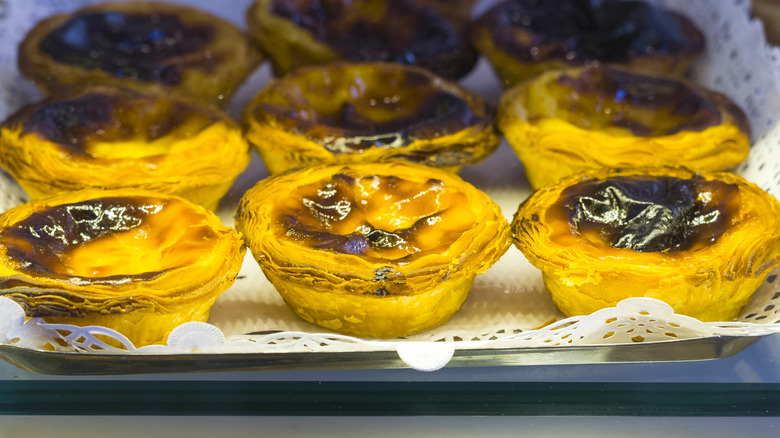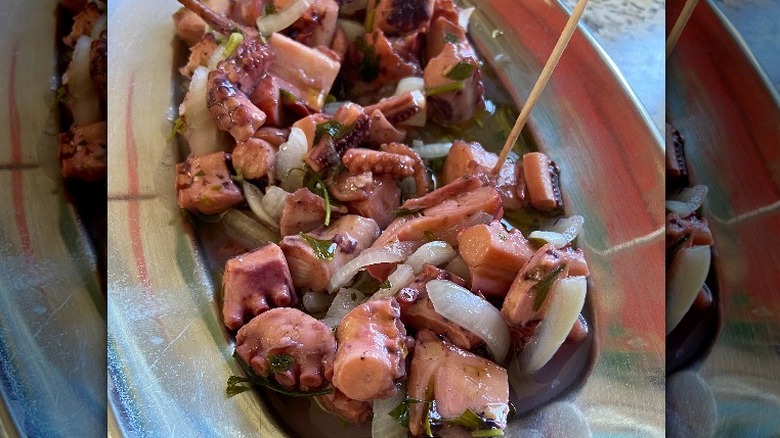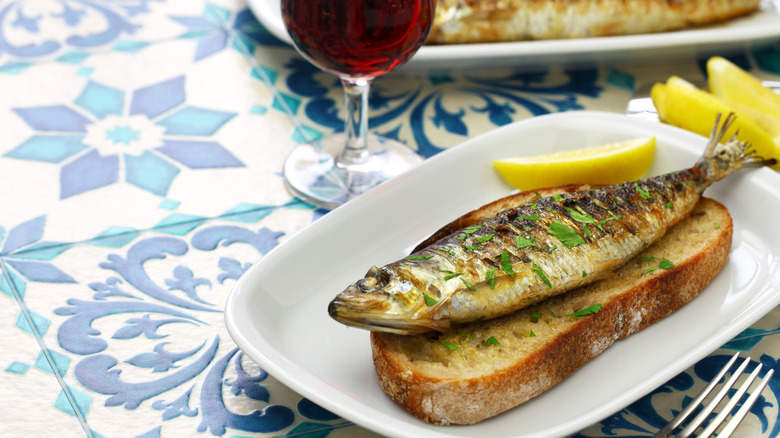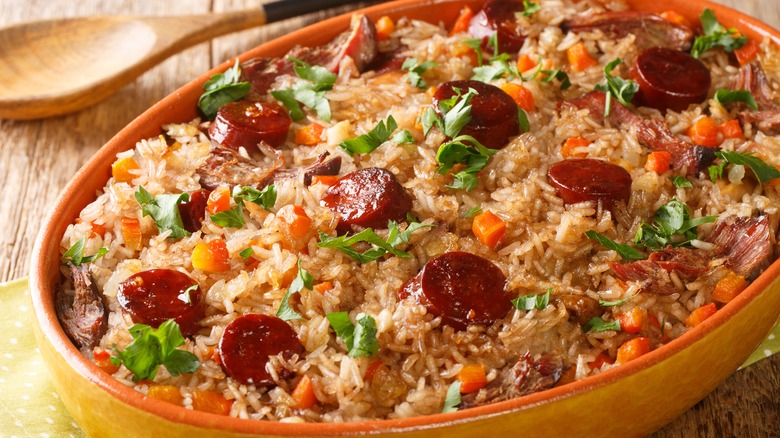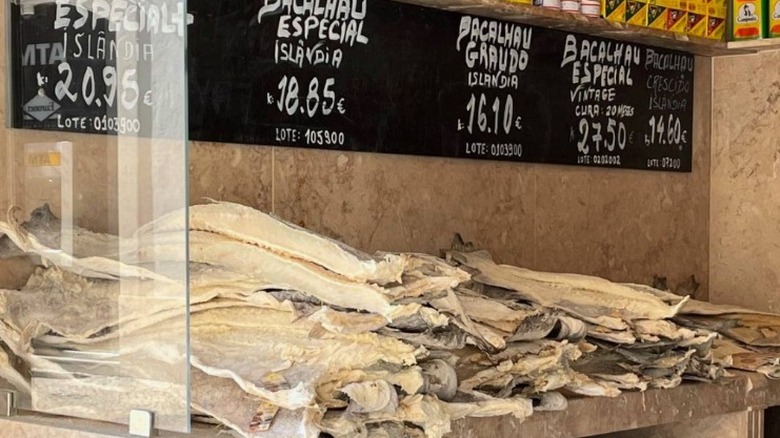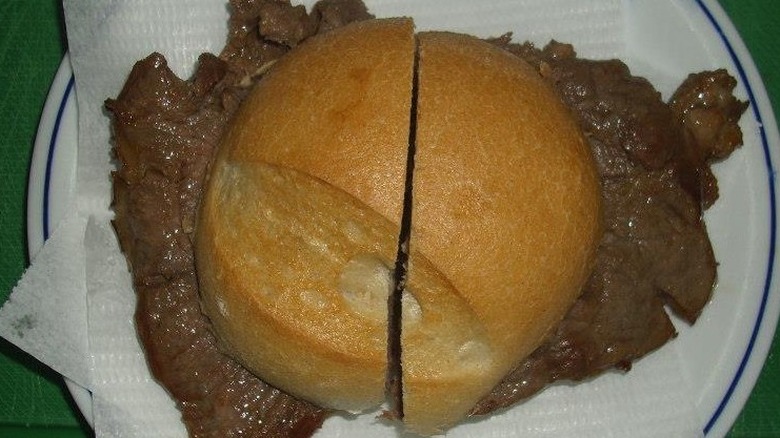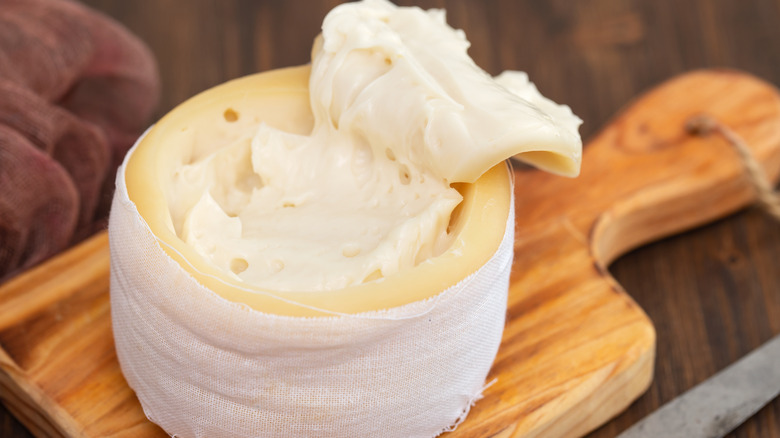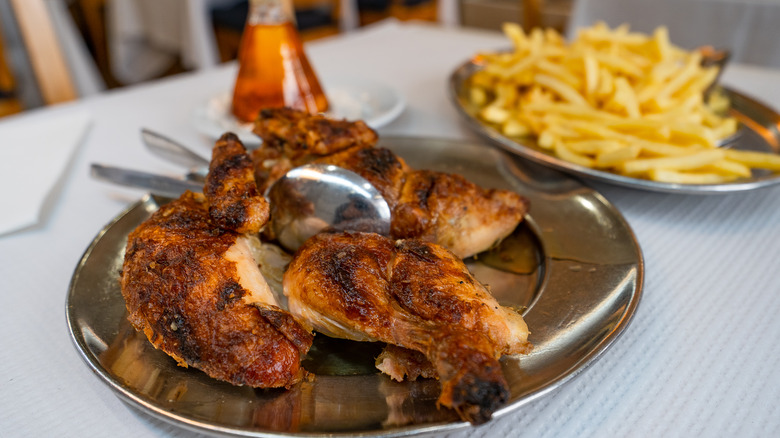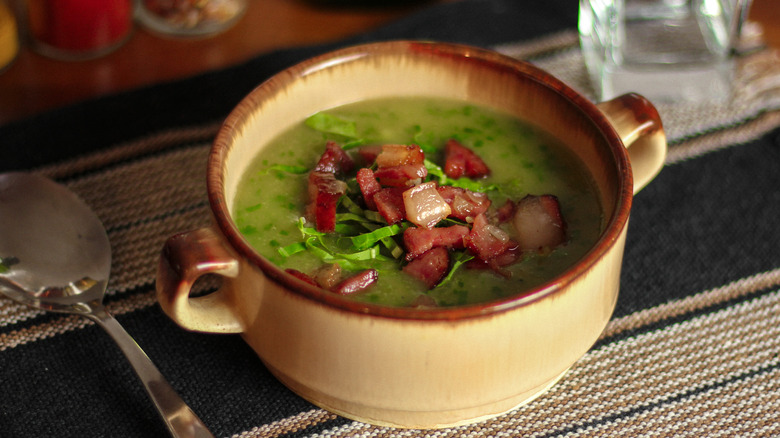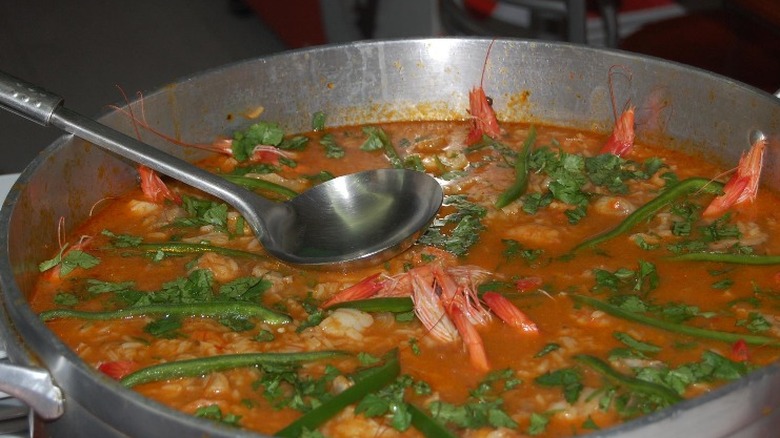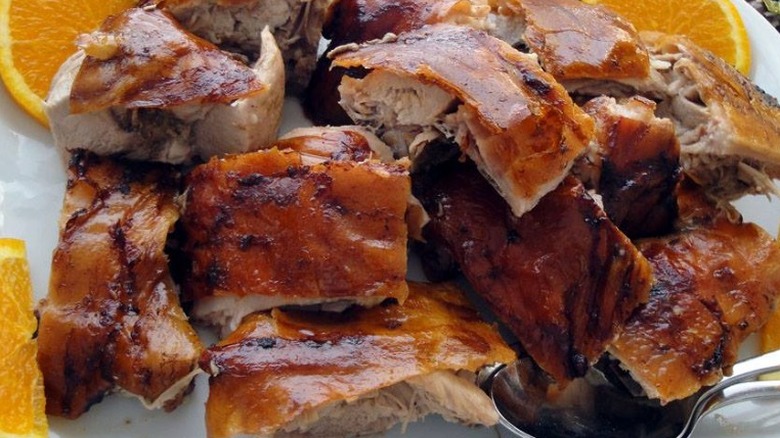17 Foods You Have To Try When Visiting Portugal
With a beautiful Atlantic coastline, a collection of tropical islands under its administration, and an internal range of mountains, Portugal has long been renowned as a travel destination full of natural beauty. But, while the country's environmental wonders are enough to attract any visitor longing for new lands, Portugal's national cuisine hasn't always gotten the same amount of respect. Sure, there is wide love for national dessert wines like port or Madeira wine, but precious few foods from the country have gained as wide of international acclaim.
When you consider the food capitals of Europe, it's hard to compete with Spain's tapas culture or the plentiful bowls of pasta that overflow from the borders of Italy. For too long, Portuguese fare was under-appreciated and overlooked for its agrarian or peasantry roots. Yet, as travel to the country returns to pre-COVID heights, notes Reuters, it's more and more likely that you'll soon have a trip planned to this amazing destination. Fortunately, the dining culture of Portugal is stronger than you might know, and there are loads of delicious foods you have to try when visiting Portugal. Along the way, you can rely on local guides such as Taste Porto, or you can explore freestyle. Still, this guide can help you get a head start on the whats-what of noshing in Portugal.
Francesinha
Although the francesinha, or "little French woman," is a Portuguese sandwich through and through, the composition is calorific enough to make you think it was dreamed up by a crew of stoners set loose in an American diner. In fact, the dish has international origins: The first francesinha was crafted in France by a Portuguese man named Daniel David da Silva, notes Atlas Obscura, who modeled it after the famed croque monsieur (and then topped the sandwich with a spicy sauce inspired by the fiery French women he met along the way). Returning to the city of Porto, Silva began slinging this behemoth at the restaurant Regaleira, says Culinary Backstreets. From there, it oozed its way across town. The sandwich can be found nationwide, but Porto remains the best place to try it.
So, what goes into a francesinha? The stack starts with two thick slices of white bread. You'll find steak, layers of cured ham, and savory linguiça sausage sandwiched between. The meat tower is then topped with melted cheese and a succulent red sauce stewed from tomatoes, chilies, and beer. If you are looking to burst the buttons off of your pants, then you can add a perfect fried egg to top it off. The recipe for francesinha will vary slightly depending on what café or bar you're eating at, but no matter where you go, you'll be carrying it with you for a few days.
Alheiras
In 2011, the Portuguese Ministry of Culture started a difficult task. Its mission was to define the national cuisine through a compilation of foods representing the country's various regions, says We Travel Portugal. After narrowing the choices to 21 options, the selected dishes were put to a public vote, notes DN Portugal. The resulting list is now known as the Seven Wonders of Portuguese Gastronomy. Of this collection, alheira — specifically alheiras de Mirandela — is one. Horseshoe in shape, alheiras is a sausage that is inconspicuously missing one important ingredient; pork.
Stuffed with poultry, garlic, breadcrumbs, and a mix of fats, alheiras de Mirandela is delicious in its own right. Yet, the true virtue of this sausage may be in its history. In 1536, the Spanish Inquisition reached Portugal (via the BBC). During a time when Jewish people were being persecuted across the countryside, a lack of pork sausage hanging at home could be a dangerous signal that the residents were not practicing Christians. To trick Inquisitors, a breaded sausage was created to mimic the appearance of non-kosher foods, and the existence of this substitute sausage is believed to have saved thousands of lives. These days, you may find alheiras de Mirandela sausage filled with wild game, poultry, or even pork, though it's still possible to get kosher, vegetarian, and vegan versions. The flavor is smokey and more garlicky than many other types of regional sausages, with a softer texture and an essence of importance.
Bolo do Caco
Few foods are as ubiquitous across the globe as garlic bread. From ancient Rome to the garlic naans of India to Texas toast, there is something so simple, supple, and standard about a warm piece of buttery bread studded with spicy aromatics. That said, it should come as no surprise that Portuguese cuisine, which is the epitome of unpretentious comfort food, has its own unique garlic bread technique – Bolo do caco.
The first thing to know about bolo do caco is that it is absolute perfection. Buttery and piquant, crisp on the outside yet pillowy on the interior, it's not only easy to eat but actually begs to be devoured quickly and while still hot. Circular bolo bread — made from leavened wheat flour, mashed sweet potato, and salt — is unique to the Portuguese island region of Madeira, reports Taste Atlas. But, it should be worshipped worldwide. The dish is traditionally cooked on a hot stone but can also be toasted on a metal pan. Typically, bolo do caco is eaten two ways; as either a garlic bread appetizer or as the bookends of a sandwich. After eating twenty-plus orders of this bread over just two months, it's our opinion that it doesn't matter how you eat bolo do caco, so long as you do.
Bifana
During a tour with a local company called Taste Porto, we were introduced to the hearty bifana sandwich, and now there is no going back. Although Taste Porto asserts that the origins of this decadent sandwich are a little fuzzy, the taste is anything but. Big, bold, and thoroughly flavorful, bifana is a clear choice when you need something to satisfy a snack craving. Bifana is a simple dish of garlicky pork steak nestled between a bread roll, though you'll find that from the north to the south (and even within those regions), everyone serves it a little differently.
In northern Portugal, you're likely to find bifana with more juice. Having been simmered in a spicy sauce, the pork steak comes in smaller bits with a near-shredded texture. This style makes the bread moist, too, and the overall effect is mouthwatering and heartbreaking. Every bite brings you closer to a moment where your bifana is gone. But don't worry, you can always order another. In the south of Portugal, the steak for bifana isn't cut but instead smashed with a mallet and paired with more garlic but less sauce. Here, it's recommended with a touch of mustard at most. While not dripping like the northern version, there's a lot of flavor in these bifanas too. Because of the regional difference, we recommend eating as many as possible. You know, for research.
Picado
Picado, or picadinho, is another food specific to the Portuguese island region of Madeira. It is as laid-back and approachable as the people of the archipelago. Picado starts with a base of meat, which can be anything from beef steak tips to veal, chicken, sausage, or a mix of all three. Per the Portuguese Historical Museum, a hungry traveler can even find picado featuring seafood delicacies like octopus or squid. After the protein is chosen, it's simmered in a wine sauce along with salt, pepper, crushed garlic, bay leaf, and a tomato puree.
The resulting mix is served on an oblong platter and surrounded by piles of hot and crispy french fries. Picado is incredibly savory, spicy in all the right ways, and large enough to share with a group of friends — at least if you don't mind sharing. It's the perfect bar food, easy to nibble on with a toothpick among sips of cold cerveja.
Pastel de Nata (Belém)
Though there are Seven Wonders of Portuguese Gastronomy, pastel de nata might be the one food to rule them all. Sweets play an important role in the food culture of Portugal, so it tracks that this food can be found in nearly any café, restaurant, or snack bar you enter here. Pastel de nata is a custard-filled tart cupped with flakey pastry, slightly scorched on top, and with a sprinkle (or downpour) of cinnamon, depending on your taste. You might see it called pastéis de nata, which is the plural version, an important thing to remember as you'll probably want to order multiple.
Another name for pastel de nata is pastéis de Belém, though the latter name is more than another title. It is a location-specific designation that again derives from a time of religious persecution in Portugal. During the 18th century, members of the Jerónimos Monastery in Belém would use leftover yolks to make small custard treats, reports Pastéis de Belém. Following a liberal revolution in the 1820s which shuttered monasteries countrywide, members of Jerónimos Monastery were forced to provide for themselves in new ways. Merchants began selling these custards next to the monastery, and today, the original recipe can still be tasted at Fábrica de Pastéis de Belém.
Salada de Polvo
According to the European Commission, Portugal has the highest consumption of seafood per capita in the entire world. There are several drivers for this that actually don't include geography — for example, codfish is an important food in Portugal despite not being present in the waters surrounding the country. Still, marine resources are plentiful around the Atlantic Coast, leading to dishes like salada de polvo (or octopus salad), which is a must-try food when visiting Portugal.
Like most Portuguese plates, salada de polvo has regional variations, but overall it is very similar to ceviche made with octopus. However, rather than served raw, the octopus is cubed and boiled for long enough to tenderize the seafood but short enough to keep it from turning chewy. After boiling, the octopus is combined with extra-virgin olive oil, cilantro, and onion. Sometimes there may be olives or peppers mixed in as well. Typically, salada de polvo is served cold for a light, refreshing summer meal.
Sardinha Assada
At one point in recent history, regional newspapers in Portugal estimated that the country's residents were eating 13 sardines every second, notes Portugal Resident. As we've seen, there is a particularly heavy appetite for seafood in Portugal, and this is especially true when it comes to preserved and canned fish, referred to in the country as conservas. Fortunately, if tinned seafood isn't your thing, you can still try some of the local seafood without having to pop a top. Sardinha assada, or grilled sardines, is one way to do so.
This dish is as dressed down as they come, but don't take that as meaning it is lacking. Instead, the unctuous flavor of sardines is complimented by rich olive oil and enhanced through the charred, smokey flavor granted by grilling (via Taste Atlas). Then, tangy lemon juice, a pinch of salt, and bright cilantro accent the simple fish plate. Eat them with bread for a heartier appetizer, or keep an eye out for sardinha assada served as easy-to-gobble-down street food. After all, there is a reason that this is one of the seven wonders of Portuguese gastronomy, says We Travel Portugal.
Jesuíte
During our time with Taste Porto, we were fortunate to be introduced not only to savory dishes like bifana sandwiches but also to sweet snacks such as jesuíte. Another dish of mixed origins, Taste Atlas suggests it's widely accepted that this pastry first originated in Santo Tirso, a city in the northwestern part of Portugal. Like pastel de nata, jesuíte is considered to be a doces conventuais, or convent sweet, meaning this sugary confection was originally made in convents or monasteries.
Jesuítas are fairly common to find across Portugal, though they are most common in the north. They are made from millefeuille pastry and egg whites, heavenly layers adding a texture that is delicate and delightful, notes Not Quite Nigella. Topped with a sugar glazing that smacks of cinnamon notes, you might be tempted to make a joke that the jesuíte looks like a Pop-Tart, but you're better off refraining. After you taste this treat, you'll understand that they deserve more respect than a comparison to America's mass-produced breakfast bites. Keep an eye out for jesuítas topped with almonds — these are delectable enough to make anyone believe in a higher power.
Arroz de pato
Wherever you look, Portuguese cuisine is full of plates and recipes that will fill up both your stomach and your spirit. The traditional forms of this cuisine are rooted in hearty foods that provide sustenance and happen to taste great as well. Many Portuguese cooking styles and techniques are agrarian in nature but have been inspired by the maritime nation's access to a world of trade routes and the ingredients that flowed along them. Take rice, for example. While not native to Portugal, this grain plays an important part in nourishing the national appetite, particularly in arroz de pato.
Arroz de pato, or duck rice, is one of those creations that embodies some of the best qualities of Portuguese cuisine (via We Travel Portugal). First, duck meat is seared in its own fats. Port wine is used to deglaze the pan, and then the game poultry is simmered with broth, bay leaf, chouriço (chorizo) sausage, and a mix of seasonings and aromatics. A few more steps — some blending, some straining — are taken in between, then the mixture is combined with carolino rice and baked. The result is a rich, fatty, succulent combination that will float through your mind like ducks over a pond.
Bacalhau
It should be said first that bacalhau is one dish and 1,000 dishes all at once, reports We Travel Portugal. How is this possible? Well, for starters, bacalhau itself is just the name for salted cod, an ingredient that is omnipresent in Portugal from the north to the south to the islands. With that definition, you can define bacalhau as a single component of culinary use. Yet, there are about as many preparations for this preserved fish as there are Portuguese people, each one calling for a different set of ingredients.
Start with bacalhau à Brás, notes We Travel Portugal, which is a common way to find salted cod in Lisbon. It's mixed with shredded potato, egg, onion, garlic, parsley, and some olives. There is pastéis de bacalhau, or bolinhos de bacalhau, both of which are a type of fried cod fritter full of salty, punchy flavors. Another common creation is bacalhau com nata, aka codfish with cream. This dish is sort of like a cod casserole, baked with potatoes, bechamel, and melty cheese. The strong aroma and flavor of bacalhau may not be for everyone, but it is one food you have to try when visiting Portugal.
Prego no pão
Prego sandwiches don't rank among the most interesting foods in Portuguese cuisine, nor do they have an honored place as a wonder of the country's gastronomic world. Yet, despite a lack of accolades and nothing to make them exceptionally fascinating, prego no pão is something you're likely to find wherever you go. It is a straightforward sandwich for the masses, and one rumor of its origin supports this characterization. Per We Travel Portugal, a legend goes that prego no pão was imagined by a business owner from Praia das Maçãs, Sintra, whose name was Manuel Dias Prego. Accordingly, he created the sandwich to be an easy sell (which it still is today).
Another story claims that the food is named after the Portuguese word for nail, "prego," because of the way it is crafted. Prego no pão is a steak sandwich in which a thin piece of meat has been nailed, or pounded, with roasted garlic. Literally, the garlic is hammered into the steak. The meat is rarely marinated or sauced; instead, the sandwich can come with a bit of mustard or cheese along with the option to have it com ovo, meaning with an egg on top. It's all served on a soft bread roll and comes ready for you to sink your teeth into.
Queijo
It's no exaggeration to say that Portugal isn't widely-regarded as a destination for cheese lovers. For the most part, you might consider France, Germany, or Italy if you're looking for cheese-based tourism. When it comes to cheese production in the European Union, Portugal was not even in the top 20 as of 2019 (via Nation Master). However, we believe that in this case, statistics may not tell the whole picture — and the Portuguese people agree, which is why they voted queijo Serra da Estrela as one of their Seven Wonders of National Gastronomy, notes We Travel Portugal.
With the exception of a small few varieties, we've found many Portuguese kinds of cheese (like Serra da Estrela) to be exceptionally soft and spreadable. In fact, the aforementioned type is never sliced. Instead, the top of the wheel is cut off, and the cheese is scooped and spread on crackers or bread. The buttery texture is slightly funky and fully artisanal, full of strong pastoral notes of thistle and grass. Other cheeses, such as saloio de Sicó, feature flavors with similar accents, blended from cow, sheep, and goat milk. As Taste of Lisboa reports, there are more cheeses to try when you're visiting Portugal, so remember to shop local and look for a queijo that represents the region you're touring.
Frango assado com piri piri
Many Portugal meals come from a storied history. Frango assado com piri piri, which is grilled chicken in a spicy pepper sauce, does not have such a long-standing backstory. At least, not in a direct sense.
Taste Atlas writes that narratives place the birth of this dish somewhere in the 1970s, having developed after Portuguese ex-pats returned to the mainland from former territories in Africa. As they had done for generations of oppressive rule, the Portuguese returned with a precious resource; Piri piri, a spicy chile pepper. Taken in that sense, frango assado com piri piri is a food that was in the works for as long as Portugal had been a colonizing empire, which is to say a long time.
Frango assado com piri piri is an ordinary plate to find across the country, though it is most frequently seen in the southern region of Algarve, notes Taste Atlas. The spicy pepper sauce is combined with other tangy ingredients, like lemon, vinegar, and sometimes even whiskey, along with an infusion of garlic and herbs. The dressing tops charred chicken quarters in a zipping sauce that bursts with complex notes in every mouthful. Most often, it's accompanied by fries, rice, or a simple salad (or all of those combined). Ordering it is sure to deliver you one of the most unique chicken plates you've ever tasted, but do take some time to consider the history as you enjoy it.
Caldo Verde
Caldo verde is another food labeled as one of the Seven Wonders of Portuguese Gastronomy, reports We Travel Portugal. This honor can be attributed to caldo verde's simple, sustaining nature. The name translates plainly to green soup, but this shouldn't give you the impression that it is light like a salad or trendy juice.
As The Guardian reports, the specific varieties of ingredients may change depending on the cook (water versus stock is a fierce debate), but the vigorous body of caldo verde should always be fortified the same way: Add alliums to add aroma and depth, starchy potatoes that have broken down to thicken the soup, hearty greens that haven't wilted too much, and sausage to add some oomph. When you see a caldo verde on the menu in Portugal, you can't not order it. Caldo verde makes a filling appetizer that will warm you from head to toe while also showing you the qualities loved about Portuguese cuisine.
Arroz de Marisco
If you are like us, there was a moment of disconnect when you first heard of arroz de pato (duck rice, if you don't remember). After all, Portugal is a massive consumer of seafood, and the country's next-door neighbor, Spain, is renowned for its own national plate, which piles bushels of seafood atop hills of rice (yes, we're talking about the authentic Spanish dish, paella). So, it left us wondering where the seafood rice was to be found on the east side of the Iberian Peninsula. As they say: Ask, and you shall receive. Duck rice may be one must-have food when visiting Portugal, but it isn't the only form of rice you should be on the hunt for. Order up a pot of arroz de marisco, and you'll see why.
The biggest difference between arroz de marisco and paella is that the latter dish is less of a stew and slightly drier (via Taste Atlas). Instead, the Portuguese version of seafood rice is cooked with a bit more juice, which stems from the natural liquids of the seafood (mussels, clams, prawns, and/or squid) as well as from a base of dry white wine and water. The result is a saucy stew simmered with crashing waves of flavor. Beyond the ocean's bounty, you'll find a typical roster of regional ingredients, including bundles of garlic, onion, tomato, and carrot. Arroz de marisco is the sixth wonder of Portuguese gastronomy on our list.
Leitão da Bairrada
The seventh and final wonder of Portugal's culinary world is a dish that hails from a small city in the central region of Bairrada. Even the name of this town conjures the image of decadent plates of food; Mealhada is the home of the famed leitão da Bairrada, says Taste Atlas, or roasted suckling pig. Leitão da Bairrada has an unmatched texture and flavor which comes from the cooking technique and the very habitat where the pigs forage.
Bairrada is regarded as a wine region, but it is also known as a place where acorns are plentiful. The local species of pig eat these in abundance, which adds a nutty, mineral characteristic. To get the customary contrast of ultra-crispy skin and soft underside, the suckling pig is stuffed with aromatics and herbs, skewered, and roasted over a fire of eucalyptus and vinewood. As it cooks, it is basted with fat, salts, seasonings, and white wine (via Rotada Bairrada). The result is a crackling exterior that remains attached to a sultry, full-flavored layer of soft pork underneath. To maintain the texture, the sliced pieces are always served skin-side up and never overlapping. Your plate may come with french fries, boiled potatoes, or salad, but it will be hard to focus on anything other than the main course.
